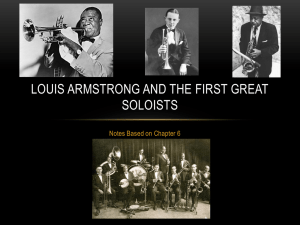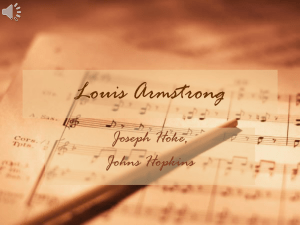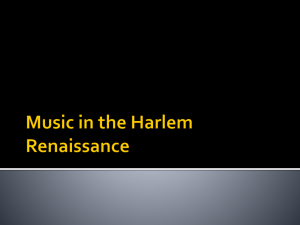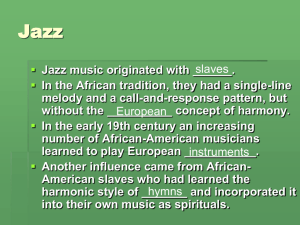History of Music, Mr. Robert L. Johnston
advertisement
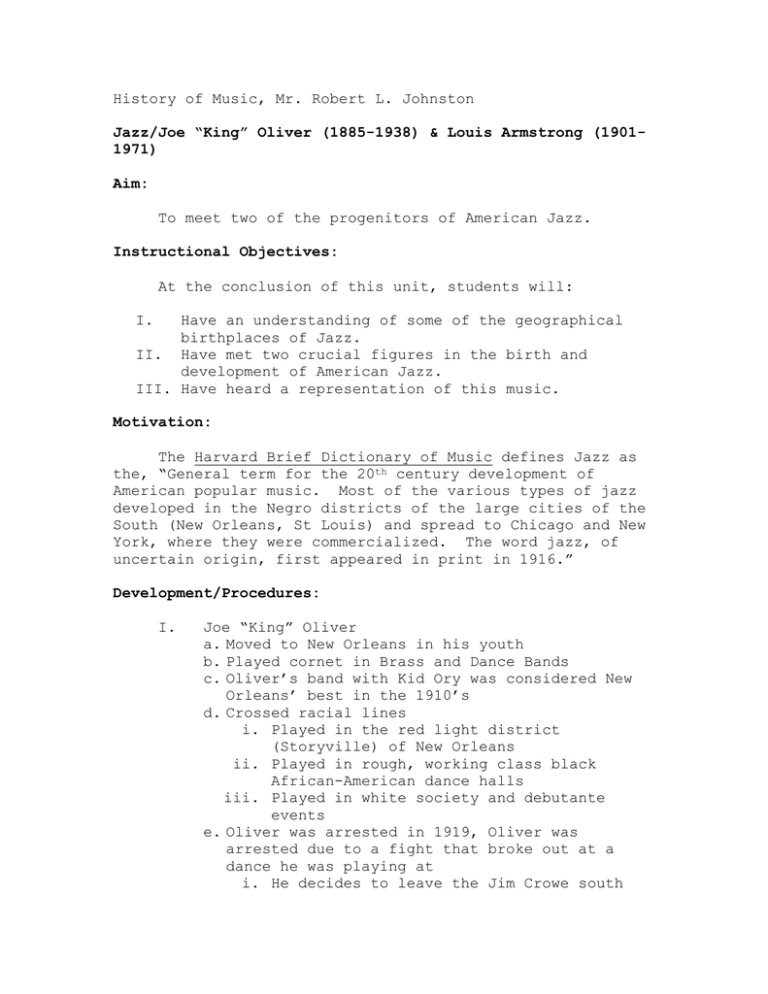
History of Music, Mr. Robert L. Johnston Jazz/Joe “King” Oliver (1885-1938) & Louis Armstrong (19011971) Aim: To meet two of the progenitors of American Jazz. Instructional Objectives: At the conclusion of this unit, students will: I. Have an understanding of some of the geographical birthplaces of Jazz. II. Have met two crucial figures in the birth and development of American Jazz. III. Have heard a representation of this music. Motivation: The Harvard Brief Dictionary of Music defines Jazz as the, “General term for the 20th century development of American popular music. Most of the various types of jazz developed in the Negro districts of the large cities of the South (New Orleans, St Louis) and spread to Chicago and New York, where they were commercialized. The word jazz, of uncertain origin, first appeared in print in 1916.” Development/Procedures: I. Joe “King” Oliver a. Moved to New Orleans in his youth b. Played cornet in Brass and Dance Bands c. Oliver’s band with Kid Ory was considered New Orleans’ best in the 1910’s d. Crossed racial lines i. Played in the red light district (Storyville) of New Orleans ii. Played in rough, working class black African-American dance halls iii. Played in white society and debutante events e. Oliver was arrested in 1919, Oliver was arrested due to a fight that broke out at a dance he was playing at i. He decides to leave the Jim Crowe south f. Oliver eventually settles in Chicago and forms King Oliver’s Creole Jazz Band i. The band included Louis Armstrong, Oliver’s protégé ii. The band included 1. 2 cornets 2. Clarinet 3. Trombone 4. Piano 5. Drums 6. Bass doubling banjo a. The banjo is an important instrument we will not have time to cover in depth g. The 1920’s saw the band presenting music that was a hybrid of New Orleans style Jazz as well as dance music h. Play Dippermouth Blues, by King Oliver’s Creole Jazz Band (2:36) i. Recorded in 1923 ii. Recording includes a young Louis Armstrong i. Bad business decisions left him working as a janitor in Georgia, where he eventually died j. Made his mark as a player and composer i. Play Oliver’s Weather Bird (2:45) ii. Recorded by Louis Armstrong and Earl Hines in Chicago in 1928 k. Louis Armstrong said of “King” Oliver, “If it had not been for Joe Oliver, Jazz would not be what it is today.” l. You will note that we have seen two important cities that were beds of development for Jazz, New Orleans and Chicago m. Joseph Oliver, about 1915 http://en.wikipedia.org/wiki/Image:Joe_King_Oliver_c._1915. jpg II. Louis Armstrong a. Born in New Orleans b. Protégé of “King” Oliver c. Developed a unique style of both playing and singing i. Note various techniques such as vibrato, scoops, use of rests and space, and “variating the melody” ii. He was an innovator of improvisation iii. Because of him, the trumpet became a solo instrument in Jazz iv. Helped popularize scat singing v. Play West End Blues (3:20) 1. Co-written by “King” Oliver 2. Recorded in Chicago in 1928 by Louis Armstrong & His Hot Five 3. This tune features Armstrong’s signature trumpet flourish vi. Play Potato Head Blues (3:03) 1. Written by Armstrong 2. Recorded in 1927 in Chicago by Louis Armstrong & His Hot Seven d. Had a recording career that lasted over the course of five decades i. Had his own small groups, as well as his own orchestra ii. Play I Gotta Sing The Blues (2:57) 1. Recorded by The Louis Armstrong Orchestra in Chicago in 1933 e. Composed countless Jazz standards f. Collaborated with countless artists i. Play George Gershwin’s You Can’t Take That Away From Me (4:40) 1. This is from a series of recordings with Ella Fitzgerald g. Appeared in over 30 movies h. Prolific writer, including two autobiographies, articles, memoirs and letters i. Countless accolades, awards and recognitions j. Louis Armstrong, London, c. 1934 http://www.satchmo.net/bio/ k. Louis Armstrong's stage personality matched his flashy trumpet. Armstrong is also known for his raspy singing voice http://www.thewineandrosesweddingband.com/images/musicstyle s/Louis_Armstrong2.jpg l. Died while a resident of Queens i. His house is now a museum Materials of Instruction: Smart Board Various Recordings Summary: Jazz is a form unto itself, with a varied and profound legacy. It is uniquely American and in the scope of Western Art Music, is one of the few genres we as Americans can claim. Its growth and development was significantly faster than that of traditional “Classical” music and has run the full scope from infancy to avant-garde and experimental in less than a century. Compare this to the music we have studied to this point. Jazz also speaks to the broader culture of America, as well as its hurdles, such as racial equality and acceptance. It is impossible to cover Jazz in anyway thoroughly in a mere three lessons, and I encourage you to explore as much as you can on your own. Assignment: Visit the Louis Armstrong House and Archives for 5 points extra credit on your 4th Quarter grade. Bring back admission ticket/receipt. Bibliography: The Harvard Brief Dictionary of Music, Willi Apel and Ralph T. Daniel, Washington Square Press, New York. 1960 http://en.wikipedia.org/wiki/Joe_%22King%22_Oliver http://www.satchmo.net/bio/ http://en.wikipedia.org/wiki/Louis_Armstrong The Smithsonian Collection of Classic Jazz, Volume I, (c) 1987, Smithsonian Institution, (p) 1987, CBS records, Inc. Ella Fitzgerald & Louis Armstrong, The Best of Ella Fitzgerald & Louis Armstrong, (p) 1997 UMG Records Suggested Reference: http://www.satchmo.net/ Robert L. Johnston
